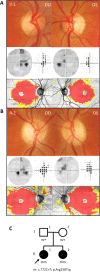Recessive MECR pathogenic variants cause an LHON-like optic neuropathy
- PMID: 37734847
- PMCID: PMC10804020
- DOI: 10.1136/jmg-2023-109340
Recessive MECR pathogenic variants cause an LHON-like optic neuropathy
Abstract
Background: Leber's hereditary optic neuropathy (LHON) is a mitochondrial disorder characterised by complex I defect leading to sudden degeneration of retinal ganglion cells. Although typically associated with pathogenic variants in mitochondrial DNA, LHON was recently described in patients carrying biallelic variants in nuclear genes DNAJC30, NDUFS2 and MCAT. MCAT is part of mitochondrial fatty acid synthesis (mtFAS), as also MECR, the mitochondrial trans-2-enoyl-CoA reductase. MECR mutations lead to a recessive childhood-onset syndromic disorder with dystonia, optic atrophy and basal ganglia abnormalities.
Methods: We studied through whole exome sequencing two sisters affected by sudden and painless visual loss at young age, with partial recovery and persistent central scotoma. We modelled the candidate variant in yeast and studied mitochondrial dysfunction in yeast and fibroblasts. We tested protein lipoylation and cell response to oxidative stress in yeast.
Results: Both sisters carried a homozygous pathogenic variant in MECR (p.Arg258Trp). In yeast, the MECR-R258W mutant showed an impaired oxidative growth, 30% reduction in oxygen consumption rate and 80% decrease in protein levels, pointing to structure destabilisation. Fibroblasts confirmed the reduced amount of MECR protein, but failed to reproduce the OXPHOS defect. Respiratory complexes assembly was normal. Finally, the yeast mutant lacked lipoylation of key metabolic enzymes and was more sensitive to H2O2 treatment. Lipoic Acid supplementation partially rescued the growth defect.
Conclusion: We report the first family with homozygous MECR variant causing an LHON-like optic neuropathy, which pairs the recent MCAT findings, reinforcing the impairment of mtFAS as novel pathogenic mechanism in LHON.
Keywords: Genetics, Medical; Neuromuscular Diseases; Ophthalmology.
© Author(s) (or their employer(s)) 2024. Re-use permitted under CC BY-NC. No commercial re-use. See rights and permissions. Published by BMJ.
Conflict of interest statement
Competing interests: None declared.
Figures




References
Publication types
MeSH terms
Substances
LinkOut - more resources
Full Text Sources
Medical
Molecular Biology Databases
